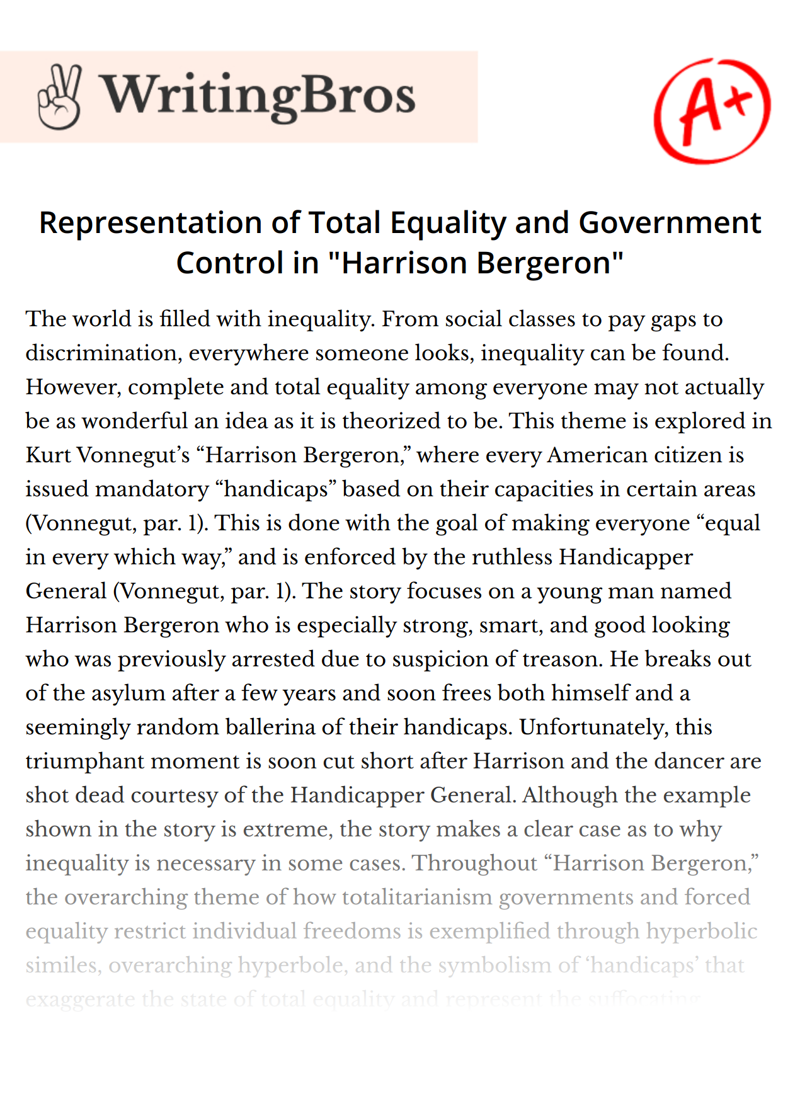Representation of Total Equality and Government Control in "Harrison Bergeron"

The world is filled with inequality. From social classes to pay gaps to discrimination, everywhere someone looks, inequality can be found. However, complete and total equality among everyone may not actually be as wonderful an idea as it is theorized to be. This theme is explored in Kurt Vonnegut’s “Harrison Bergeron,” where every American citizen is issued mandatory “handicaps” based on their capacities in certain areas (Vonnegut, par. 1). This is done with the goal of making everyone “equal in every which way,” and is enforced by the ruthless Handicapper General (Vonnegut, par. 1). The story focuses on a young man named Harrison Bergeron who is especially strong, smart, and good looking who was previously arrested due to suspicion of treason. He breaks out of the asylum after a few years and soon frees both himself and a seemingly random ballerina of their handicaps. Unfortunately, this triumphant moment is soon cut short after Harrison and the dancer are shot dead courtesy of the Handicapper General. Although the example shown in the story is extreme, the story makes a clear case as to why inequality is necessary in some cases. Throughout “Harrison Bergeron,” the overarching theme of how totalitarianism governments and forced equality restrict individual freedoms is exemplified through hyperbolic similes, overarching hyperbole, and the symbolism of ‘handicaps’ that exaggerate the state of total equality and represent the suffocating government control.
Hyperbole is a central tactic used by Vonnegut in “Harrison Bergeron” to both emphasize Harrison’s physical and mental superiority, as well as to show how total equality on a large scale is not as good an idea as some may think. Throughout the story Harrison is described as almost god-like with his size, strength, intelligence, and attractiveness all being far above anyone else in this fictional world. This image of Harrison is further expanded through the hyperbolic phrases used as he frees himself from his impairing shackles. He tears the harness meant to support 5000 pounds off “like wet tissue paper” before snapping the bar that secured it to him “like celery” (Vonnegut, par. 56-58). After freeing himself of his handicaps, it is said his looks would have even “awed Thor, the god of thunder” (Vonnegut, par. 59). This heavy use of hyperbolic similes helps present Harrison as a direct foil to the government’s tyrannical rule and forced equality. In addition to the obvious examples of hyperbole, the entire story serves as an exaggerated example of what could become of a society forced into equality. Due to the forced equality, the dystopian society is void of any technological advances, genuine emotions, or meaningful connections. While the story presents a melodramatic example, the author conveying to readers that in a society that has equality forced onto it, the results will be similar.
In the story, handicaps serve the purpose of restricting an individual’s abilities through often harsh methods, however, they also symbolize the government’s totalitarian control over the society. Handicaps in “Harrison Bergeron” come in a wide variety of impairments such as headache-inducing earpieces, cumbersome weights, or concealing masks. Despite the handicap’s intended purpose, they often do more harm than in necessary to keep the population equal. For example, Harrison’s father has an earpiece that plays a “sharp noise” every 20 seconds which effectively resets his train of thought, not allowing him to take “unfair advantage” of his own brain (Vonnegut, par. 3). Not only is this cruel but it keeps him from expressing any complex emotions or forming any meaningful connections. While these handicaps make everyday life for citizens difficult to say the least, that is not their primary reason for being included in the story. The handicaps represent the depth and severity of the government’s control in this dystopian future and are made to be as suffocating as they are to show how a tyrannical government impacts each individual differently, but that it affects everyone. This symbol is again shown when Harrison dramatically frees himself from his bindings, showing how in that moment, he liberated himself from the government’s control and gained a sense of individuality; something extremely rare in this dreadful future.
Throughout “Harrison Bergeron,” the overarching theme of how totalitarianism governments and forced equality restrict individual freedoms is exemplified through hyperbolic similes, overarching hyperbole, and the symbolism of ‘handicaps’ that exaggerate the state of total equality and represent the suffocating government control. The handicaps shown throughout the story show the drastic measure that this government is willing to take to keep their citizens ‘equal.’ However, these impairments are not just keeping their citizens from reaching their full potential, it is damaging society as a whole as the heavily hindered citizens are unable to make advances in any field or feel any sort of individuality as everyone around them has the same abilities. This lack of individuality is shown through Harrison and his god-like qualities which are accentuated through repeated use of hyperbolic phrases. He is as different as someone could be, but these qualities are negated through government issued handicaps, making him nothing more than a slave of the tyrannical rule, forced to live his life in mediocrity. However, for one gleaming moment, he was able to show the population of this dreary world how being different, being unique, is liberating. He was able to show that the suffocation of the government’s tactics represent an idea an equal utopia that cannot exist. Harrison was a symbol of individuality and freedom, and despite his tragic death, he showed that complete equality, no matter the scale, creates nothing but a dystopia where no real emotions, connections, or progress to be made; not without individuality and inequality.
Cite this Essay
To export a reference to this article please select a referencing style below

